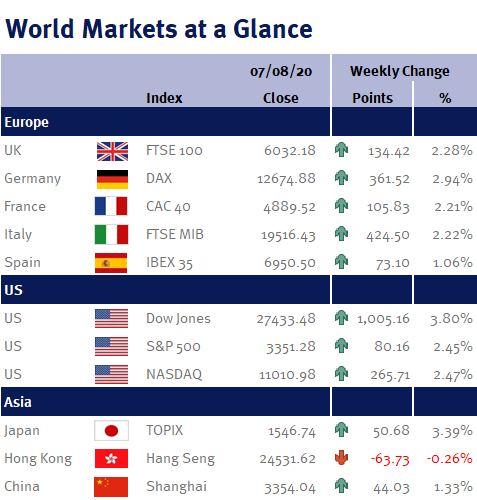It was a slow week in terms of economic data, but the data sets that were released were crucial indicators to the health and outlook of some of the major global economies. There were three key drivers to the week’s markets however, the first was that it was the busiest week in the Q2 earnings calendar, the second was seeing the US Federal Reserve Bank (Fed) policy meeting, and the third being the resurgence in coronavirus cases.
It was these factors that led to markets ending the week largely mixed, with many European markets closing negatively due to the resurgence in coronavirus cases within Spain and the subsequent travel measures put in place by other European countries (the UK imposed a 2 week quarantine period for any individuals travelling back from Spain). Countries such as Norway and France also put their own restrictions in place, putting renewed pressure on the Spanish leisure and tourism sector during the height of the holiday season. Elsewhere it was China and the US that lead the way, both closing the week’s trading in the ‘green’, seeing the Chinese Shanghai composite close the week 3.54% higher and the US S&P 500 1.73% higher.
With the above in mind and the heightened expectation surrounding Wednesday’s (29 July 2020) Fed meeting, one of the busiest weeks in the Q2 reporting calendar started out volatile for markets with streams of companies such as McDonalds, Greggs (fast food retailers) and Reckitt Benckiser (a leader in consumer health and home products) all announcing their earnings early on. This saw the majority of companies outside of healthcare, and consumer healthcare provision, expectantly report weak numbers for a quarter that factored in the lockdown period. As we have said all along, whilst the lockdown period is a sunk cost for many businesses and industries, representing a loss of earnings that they will not get back, the transitory nature of the coronavirus impact (a tragedy though it is) means that well run corporates that have worked their way through the lockdown phase have seen better than expected earnings results. In addition, their compressed market valuation represents a key buying opportunity for investors. As such, even though it is never good to see a compression in markets, the ‘noise’ driven markets early on in the week gave us an opportune buying point to purchase funds such as the Schroder US Mid Cap fund (ahead of the Fed policy meeting) and the Threadneedle European Select Fund (following the compression in European markets after the coronavirus resurgence).
Whilst the week started out largely mixed, it was the Fed policy meeting that began to steady broader markets. Even though the Fed Chair, Jerome Powell, did little to alter policy (leaving the headline interest rates unchanged at 0.25% at the upper bound), it was his reinforcement of the Fed’s accommodative stance that settled markets. With Powell stating that the Fed will remain flexible in its approach to policy given the surge in US coronavirus cases, he firmly left the Whitehouse and lawmakers under pressure to agree a fiscal stimulus package. As, with March’s original package due to run out, Powell stated that it will be the marriage of monetary and fiscal stimulus that will see the US enter a phase of economic recovery. Following this supportive message buoying a number of markets (particularly the US), it was Thursday’s (30 July 2020) reporting of the Tech giants, Amazon, Alphabet (Google), Facebook and Apple that really drove a surge in global markets. With countrywide lockdowns earlier on in the year preventing friends and family meeting, in addition to a closure of the high street, individuals were driven to shop online (Amazon), whilst staying in touch with the broader world remotely (Facebook and Google). Apple also saw a wave of demand for their products through lockdown as consumers sought technology that could allow them to access online shopping and communication. This lead to Apple posting revenues of $59.7 billion for Q2, smashing expectations by over $7 billion, with Amazon, Alphabet and Facebook also posting strong results for the quarter.
It is clear that markets were not driven by economic data sets, but rather policy, news flow and reporting. That being said, there were still some key data points announced that will support a recovery over the months to come. Earlier in the week we saw China release its industrial profits for June in addition to the US posting its durable goods orders also for June, both significantly beating expectation. Later in the week, we saw Japanese retail sales smash expectations by 4.5%, in addition to broader European inflation numbers posting strongly at 1.2% year on year. So, even though we did see some localised pockets of weak inflation in some areas of Europe (Spain and Germany), in addition to expected weak GDP growth data from the US and Europe for the quarter, data this week continued to suggest the consumer is still willing to spend. And, even though we are conscious that UK, US and European employment data will continue to be littered with noise until furlough and wage support schemes are wound up, continuing consumer demand will likely buffer any impact on employment data, wage growth and inflation.
Next week corporate earnings season continues. We will also be looking towards some key economic data points due for release including US Manufacturing, Manufacturing PMI for the UK and much of Europe, Japanese GDP, and the weekly jobless claims data for the US, amongst other things. We will also see the Bank of England policy and rate decisions announced on Thursday (6 August 2020) following the meeting of the Monetary Policy Committee.
Jonathan Wiseman, Fund Manager


